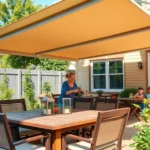Planning your vegetable garden layout can transform your backyard into a productive food paradise. Whether you’re working with a sprawling yard or a compact space we’ll show you how to maximize every square foot for abundant harvests.
Smart garden design isn’t just about throwing seeds in the ground and hoping for the best. The right layout strategy helps you grow more vegetables in less space while making maintenance easier and more enjoyable. From vertical growing techniques to companion planting arrangements these proven methods will revolutionize how you approach vegetable gardening.
We’ve compiled the most effective layout ideas that work for gardeners of all skill levels. These practical designs will help you create organized efficient growing spaces that produce impressive yields season after season. Ready to discover which layout will work best for your space and growing goals?
Square Foot Garden Layout for Maximum Space Efficiency
Square foot gardening transforms small spaces into productive growing areas by dividing garden beds into precise one-foot squares. This method maximizes yields while minimizing weeds and maintenance time.
Grid System Organization
Dividing your garden bed into individual square foot sections creates an organized framework for planting. We recommend using string, wood strips, or metal dividers to mark each square clearly. Each square accommodates different quantities of plants based on their mature size: large plants like tomatoes need one full square, medium plants like lettuce allow four per square, small plants like radishes fit sixteen per square, and tiny plants like carrots accommodate as many as nine per square.
Planning becomes simpler when you assign exact vegetables to designated squares based on their space requirements. We suggest sketching your grid layout on paper first, noting which vegetables you’ll place in each section. This visual approach helps prevent overcrowding and ensures proper spacing for healthy plant development.
Raised beds work exceptionally well for square foot gardens since they provide better drainage and soil control. We find that 4×4 foot beds are ideal for beginners, while 4×8 foot beds offer more variety without becoming overwhelming to manage.
Companion Planting Within Squares
Strategic plant pairing within your grid squares enhances growth and naturally deters pests. We place tall plants like corn or pole beans on the north side of squares to prevent shading shorter crops. Basil grows exceptionally well alongside tomatoes, improving flavor while repelling harmful insects like aphids and hornworms.
Root vegetables pair beautifully with leafy greens since they occupy different soil layers. We often combine carrots with lettuce or spinach in the same square, allowing the greens to mature and be harvested before the root vegetables need full space. Marigolds fit perfectly into corner spaces of squares, providing natural pest control for neighboring vegetables.
Three sisters planting adapts well to square foot gardening by dedicating multiple connected squares to corn, beans, and squash. We allocate one square for corn, surround it with beans in adjacent squares, and place squash in outer squares where vines can spread beyond the grid boundaries.
Succession Planting Strategies
Staggered plantings ensure continuous harvests throughout the growing season rather than overwhelming abundance followed by gaps. We plant new seeds every two to three weeks in different squares, creating a rolling harvest of fresh vegetables. Quick growing crops like lettuce, radishes, and spinach work perfectly for this approach.
Seasonal transitions become seamless when you plan cool season and warm season crops in alternating squares. We start cool weather vegetables like peas and lettuce in early spring squares, then transition those same spaces to warm season crops like peppers and eggplant as temperatures rise. Fall brings another opportunity to replant cool season varieties in recently harvested warm weather squares.
Vertical succession adds another layer to your square foot system by utilizing climbing varieties. We install trellises or cages in designated squares for vining crops like cucumbers, pole beans, and peas. This approach doubles your growing space while maintaining the organized grid structure that makes square foot gardening so effective.
Row Garden Layout for Traditional Growing

Row gardening offers a timeless approach that simplifies planting, maintenance, and harvesting through organized linear arrangements. This classic method works particularly well for larger garden spaces where vegetables grow in long, parallel lines with designated pathways between them.
Straight Row Configuration
Straight rows create the foundation of traditional vegetable garden design. We plant vegetables like carrots, beans, lettuce, and root crops in evenly spaced parallel lines that run the length of our garden beds. Orienting these rows from north to south maximizes sunlight exposure for all plants throughout the day.
Spacing between individual rows typically ranges from 12 to 36 inches, depending on the exact crops we’re growing. This arrangement allows adequate room for plant growth while ensuring proper airflow circulation. Root vegetables and leafy greens particularly thrive in this structured layout because it prevents overcrowding and makes harvesting more efficient.
Wide Row Planting Method
Wide row planting transforms traditional single-line growing into broad, continuous bands of vegetables. Instead of narrow rows, we create wider planting areas that accommodate multiple plants across the width. This technique increases our yield per square foot by reducing space wasted in walkways while boosting overall plant density.
Crops like lettuce, spinach, and radishes perform exceptionally well in wide row configurations. We space plants closer together within these broader bands, which naturally suppresses weeds by creating a canopy that shades the soil. The increased plant density also maximizes our harvest from the available growing space.
Pathway Planning Between Rows
Strategic pathway design ensures easy access to our plants throughout the growing season. Main walkways between rows should measure 18 to 24 inches for narrow paths and up to 36 inches for primary access routes that accommodate wheelbarrows and kneeling space.
Well-planned pathways prevent soil compaction in our growing areas while making garden maintenance tasks more manageable. We often mulch these walkways to reduce weed growth and keep our shoes clean during wet conditions. Proper pathway width allows us to comfortably reach plants for planting, weeding, and harvesting without disturbing adjacent crops.
Raised Bed Garden Layout for Better Drainage
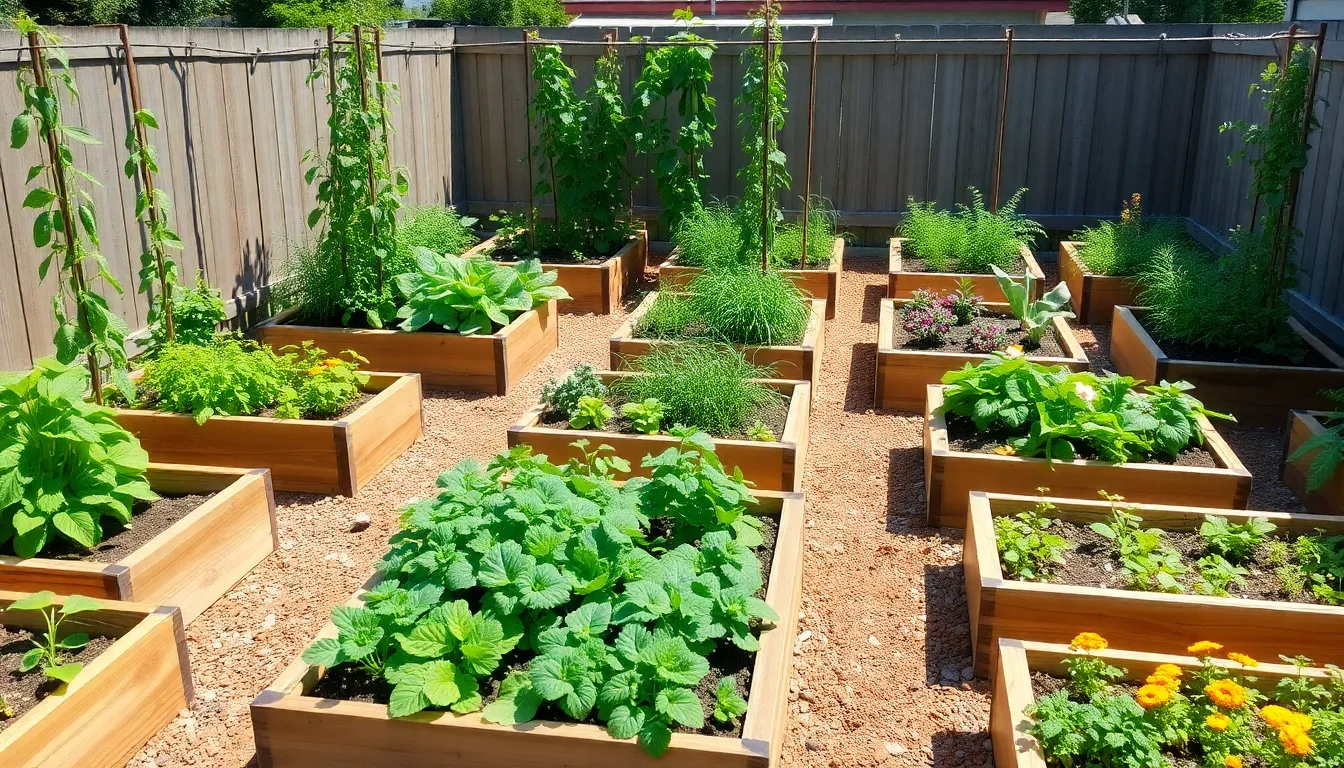
Raised beds naturally provide superior drainage compared to traditional in-ground gardens because their elevated structure allows excess water to flow away from plant roots. We recommend constructing beds at least 18 inches deep to ensure proper water movement while giving roots adequate space to develop.
Single Raised Bed Design
Single raised beds work perfectly for gardeners who want simplicity and focused crop management. We typically build these rectangular or square frames around 3 to 4 feet wide, allowing easy access from all sides without stepping into the growing area. This width ensures you can reach the center of the bed comfortably while maintaining soil structure.
Consider these advantages when choosing a single bed layout:
- Space efficiency makes them ideal for small yards or patios
- Crop specialization lets you focus on exact vegetables or herbs
- Simplified maintenance reduces the complexity of soil nutrition and watering schedules
- Clean organization creates a neat, structured appearance in your garden
Installing drainage holes or perforated pipes at the bottom prevents waterlogging and redirects excess moisture away from your plants. Some gardeners add a gravel layer at the base, though the raised structure itself usually provides adequate drainage when properly constructed.
Multiple Bed Configuration
Multiple raised beds offer incredible flexibility and maximize your growing space through strategic arrangement. We suggest organizing beds in parallel rows with walkways between them to ensure easy access for planting, weeding, and harvesting activities.
Popular configuration options include:
- Parallel arrangements with 2-3 foot pathways for comfortable movement
- L-shaped layouts that create attractive border gardens along property lines
- U-shaped designs that form enclosed growing areas with central access
- Keyhole patterns that optimize space utilization and reduce walking distances
- Formal potager styles that combine aesthetic appeal with productive functionality
This multi-bed approach enables crop rotation practices, companion planting strategies, and plant segregation based on exact water or sunlight requirements. We find that separating plants with different needs improves overall garden health and productivity.
Vertical Growing Integration
Vertical growing methods dramatically increase your planting capacity while improving plant health through better air circulation. We attach trellises or support structures directly to raised bed frames for climbing vegetables like beans, peas, and cucumbers.
Effective vertical integration strategies include:
- Trellis systems mounted on the back or sides of beds for vining crops
- Vertical towers positioned alongside beds for herbs and leafy greens
- Stacked planters that create multi-level growing opportunities
- Climbing supports that guide plants upward instead of outward
Vertical gardening reduces soil-borne diseases by keeping plants off the ground and increases planting density without expanding your garden’s footprint. This approach helps maximize yields in limited spaces while creating visually appealing garden structures that support plant growth naturally.
Container Garden Layout for Small Spaces
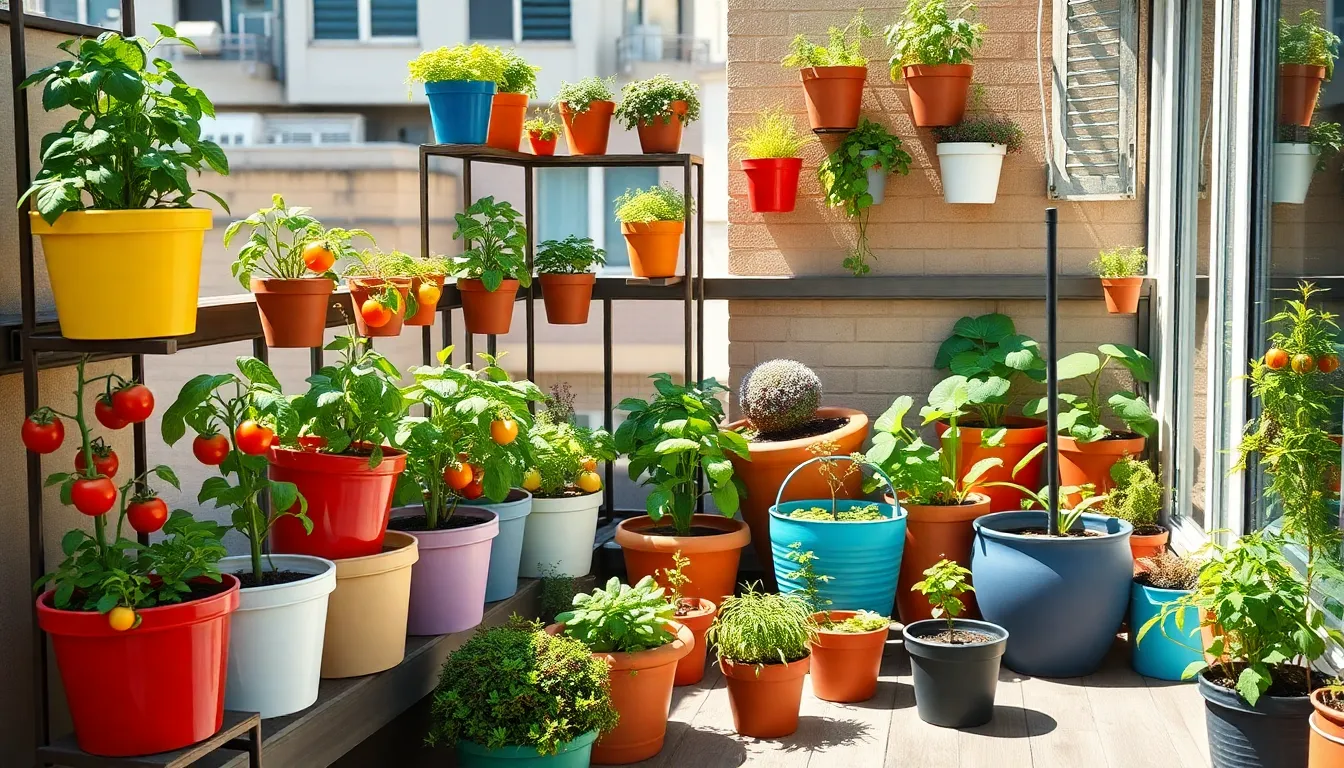
Container gardening transforms limited outdoor areas into productive vegetable growing spaces through smart arrangement and strategic placement strategies.
Patio Container Arrangement
Fill negative space on your patio by positioning containers in gaps and corners to create a lush garden atmosphere that maximizes every available inch. We recommend using creative containers like old galvanized buckets or vintage planters to add character and visual interest to your patio garden setup.
Balance rustic and modern elements by combining different container styles such as weathered wooden crates alongside sleek ceramic pots. This approach creates visual depth while maintaining functionality for your vegetable growing needs.
Group containers in odd numbers to establish ever-changing displays that naturally draw the eye and create professional looking arrangements. We suggest clustering three or five containers of varying sizes to achieve the most appealing visual impact.
Balcony Optimization Techniques
Use vertical gardening systems with wall mounted planters and shelving units to maximize growing space while improving air circulation around your plants. We’ve found that vertical arrangements can triple your growing capacity compared to floor level containers alone.
Select space saving plants like compact cherry tomatoes, dwarf peppers, and leafy greens that thrive in confined growing conditions. These varieties produce abundant harvests without overwhelming small balcony spaces.
Make use of overlooked nooks by installing wall mounted shelves or hanging baskets in corners and along railings. We recommend securing all vertical elements properly to prevent wind damage and ensure plant safety.
Vary container heights using plant stands or tiered shelving systems to create visual interest while ensuring each plant receives adequate sunlight exposure.
Mobile Container Systems
Choose lightweight materials like plastic or fiberglass containers that allow for easy repositioning as sunlight patterns change throughout growing seasons. We prefer containers with built in wheels or casters for effortless movement without straining your back.
Design flexible layouts that accommodate seasonal plant rotations and changing space requirements throughout the year. This approach lets you optimize sun exposure and protect tender plants during weather extremes.
Ensure proper drainage in all mobile containers by drilling adequate holes and using well draining potting mix to prevent waterlogged soil conditions. We recommend checking drainage regularly as mobile containers tend to shift and may develop water collection issues over time.
Spiral Garden Layout for Unique Design
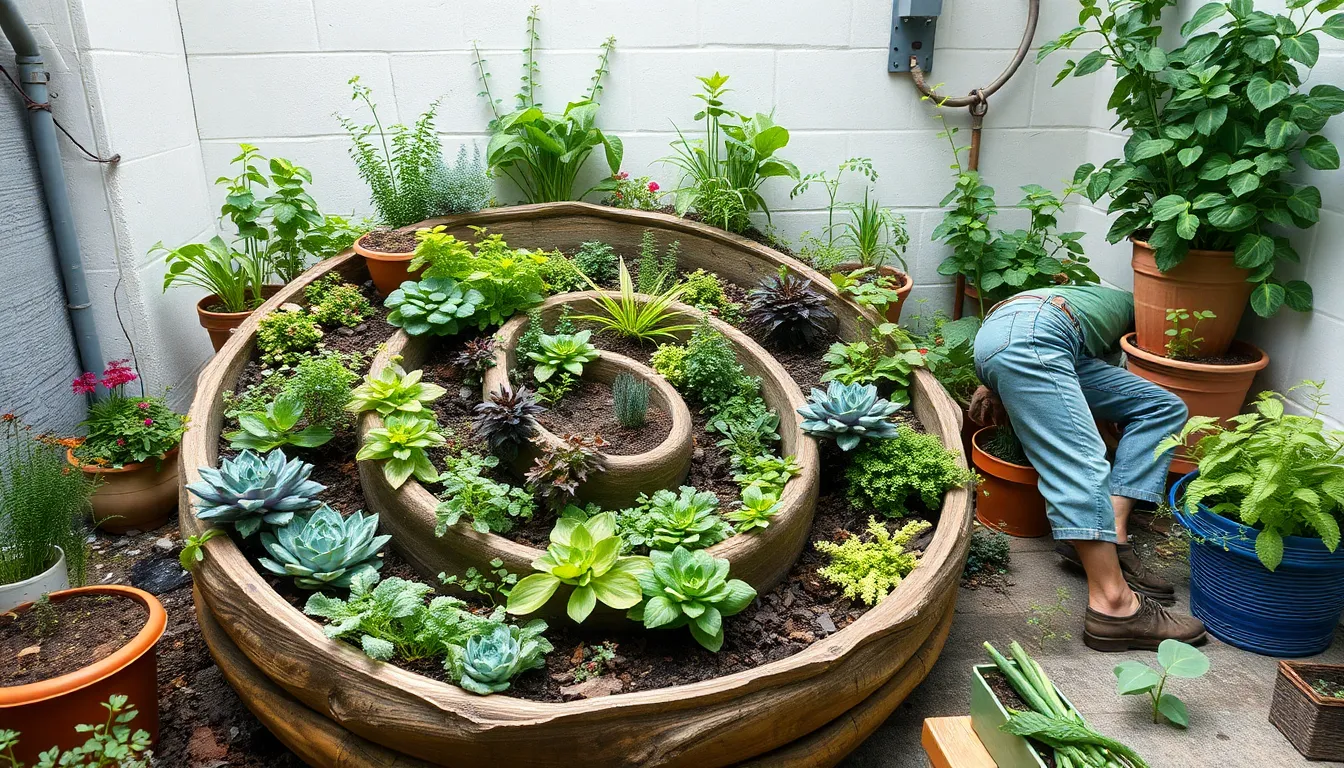
We create spiral gardens by arranging plants in a circular, ascending pattern that maximizes diversity and visual appeal in compact spaces. This distinctive layout offers both functional benefits and stunning aesthetics.
Herb Spiral Construction
We build herb spirals by mounding soil and organic matter into a structure roughly 3-4 feet in diameter with a gentle slope rising to a peak at the center. Materials like bricks, stones, or logs reinforce the sides and retain soil effectively.
Plant positioning starts at the highest point with drought-resistant herbs such as rosemary and thyme. Moving downward along the spiral, we transition to moisture-loving plants like parsley and cilantro in the lower sections. This strategic arrangement ensures each plant thrives in its optimal growing conditions.
Construction begins with creating a solid foundation using your chosen retaining materials. Building the spiral structure requires careful attention to drainage and soil composition for long-term success.
Microclimate Creation
Spiral design naturally creates distinct microclimates throughout the structure, with higher and drier conditions at the top contrasting with increased moisture retention at the base. Varying levels of sun exposure develop along the spiral curves, accommodating diverse plant requirements.
North-facing slopes provide shaded areas perfect for cool-loving crops that prefer less intense sunlight. South-facing sides offer warm, sunny spots ideal for heat-tolerant species requiring maximum solar exposure.
Temperature variations occur naturally within the spiral structure, creating opportunities to grow plants with different climate preferences in one compact area. Drainage patterns follow the spiral’s natural flow, preventing waterlogged conditions while ensuring adequate moisture reaches all planting zones.
Space-Saving Benefits
Spiral gardens save important space through vertically layered planting and compact design, making them perfect for urban gardens, small yards, or raised bed applications. Their efficient configuration eliminates the need for multiple separate garden beds.
Layered planting approaches provide easy access for maintenance and harvesting without requiring gardeners to step into planting areas. This design minimizes soil compaction while maximizing growing capacity.
Access points remain clear and functional throughout the growing season, allowing us to tend plants without disturbing neighboring crops. Vertical growing space accommodates more plant varieties than traditional flat garden layouts of similar square footage.
Keyhole Garden Layout for Water Conservation
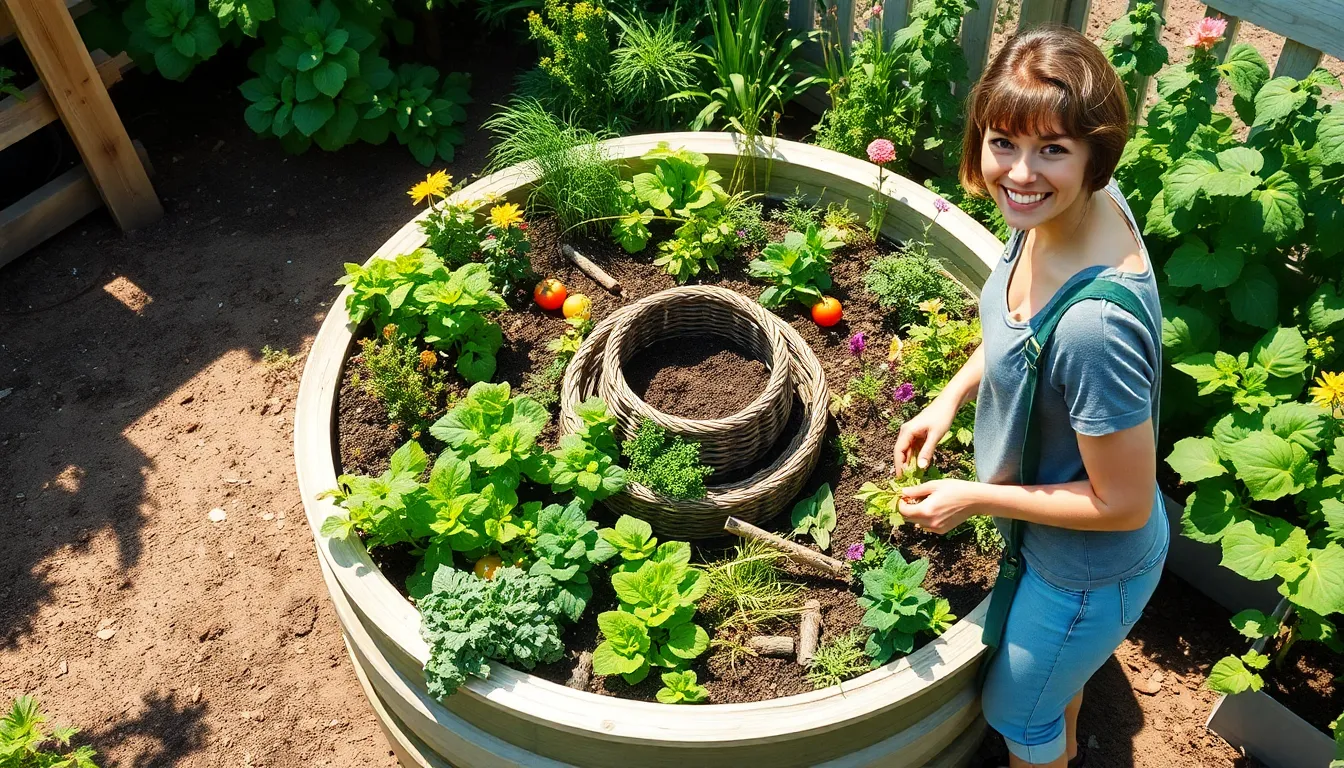
The keyhole garden layout represents a revolutionary approach to sustainable vegetable gardening. We’ll explore how this circular design maximizes water efficiency while producing abundant harvests.
Central Composting Feature
The heart of every keyhole garden features a composting basket that transforms kitchen scraps into garden gold. We position this core structure at the center of our 6-foot diameter circular bed, creating a continuous nutrient delivery system for surrounding plants. Organic waste like vegetable peelings, coffee grounds, and eggshells decompose directly in the core, releasing nutrients that naturally leach into the soil.
Water filtration occurs naturally through the compost core, distributing moisture and nutrients throughout the entire bed. We can even use grey water from our kitchen sinks, as the compost materials filter and purify the water before it reaches plant roots. This central feature eliminates the need for separate composting areas while providing constant fertilization for our vegetables.
Circular Bed Design
The raised circular structure stands roughly waist high, allowing us to reach every plant without stepping into the growing area. We access all sections through a wedge-shaped path that cuts into the circle like a keyhole, giving this design its distinctive name. This accessibility prevents soil compaction that typically occurs when gardeners walk through traditional beds.
Space efficiency reaches maximum potential with the circular layout, as curved edges provide more growing area than square beds of similar size. We position plants according to their height and light requirements, with taller crops like tomatoes and peppers toward the center and shorter herbs along the outer edges. The compact design makes maintenance tasks like weeding, pruning, and harvesting significantly simpler.
Efficient Watering System
Water conservation becomes effortless when we pour irrigation directly into the central compost core. The organic materials retain moisture and release it slowly throughout the bed, reducing evaporation by up to 90% compared to traditional watering methods. Mulched pathways and bed surfaces further suppress water loss while controlling weeds naturally.
Gravity-fed irrigation systems integrate seamlessly with keyhole designs, allowing us to set up automatic watering that requires minimal maintenance. We can incorporate swales at the base of raised beds to capture additional runoff, especially beneficial in sloped yards or areas with limited rainfall. The system adapts perfectly to rainwater collection, as the central core accepts and filters collected precipitation efficiently.
Three Sisters Garden Layout for Companion Planting
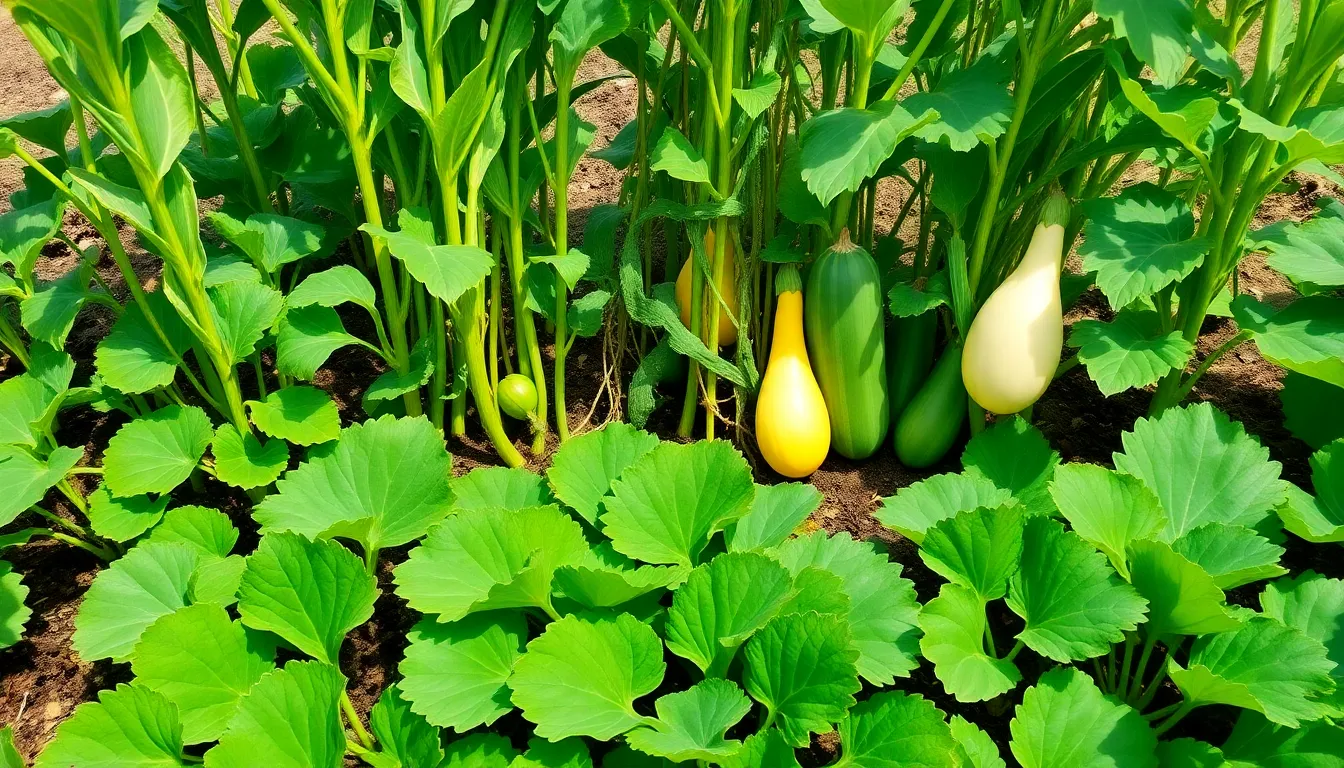
Building on efficient garden layouts, we can explore one of agriculture’s most time-tested companion planting methods. The Three Sisters Garden showcases how corn, beans, and squash work together to create a sustainable and productive growing system.
Corn, Beans, and Squash Arrangement
Corn serves as the foundation of this planting system and should be established first in clusters or staggered rows. We plant corn to promote wind pollination and create sturdy support structures for climbing beans. Starting corn before other crops ensures it develops the strength needed to support bean vines.
Beans get planted once corn reaches several inches tall, typically 2-3 weeks after corn establishment. We sow beans around the corn stalks, allowing them to climb and benefit from the natural trellis system. Beans contribute nitrogen fixation to the soil, improving fertility for all three crops.
Squash goes into the ground about a week after beans emerge, spreading along the ground around the other plants. We position squash at the perimeter, letting vines spread outward to create a living mulch. Squash leaves shade the soil, suppress weeds, retain moisture, and deter pests with their prickly foliage.
Native American Growing Wisdom
Traditional Native American agricultural practices developed this companion planting method through generations of observation and experimentation. Indigenous farmers understood that each plant benefits the others through resource sharing and mutual support systems. We can learn from this deep knowledge of plant relationships that maximizes garden productivity while working with natural processes.
Corn provides the structural foundation, beans enrich the soil naturally, and squash protects the growing environment. This wisdom reflects sustainable farming principles that modern gardeners can apply to create thriving vegetable gardens without synthetic inputs.
Soil Nutrition Benefits
Growing these three crops together creates a natural fertilization system that enhances soil health throughout the growing season. Beans fix atmospheric nitrogen, enriching the soil naturally for corn and squash to use. We benefit from this nitrogen cycling that reduces the need for external fertilizer applications.
Squash acts as a living mulch, reducing water evaporation and suppressing weed growth around the root zones. The large leaves create shade that keeps soil cool and moist, improving growing conditions for all plants. We can observe how this natural mulching system maintains soil structure and reduces maintenance requirements.
Spacing Guidelines for Three Sisters Layout:
| Plant Type | Spacing | Timing |
|---|---|---|
| Corn | Every 8 inches | Plant first |
| Beans | Every 3-4 inches | 2-3 weeks after corn |
| Squash | Every 2 feet along edge | 1 week after beans emerge |
This layout supports balanced growth, improves pollination, and optimizes both garden space and soil health through natural plant partnerships.
Vertical Garden Layout for Limited Ground Space
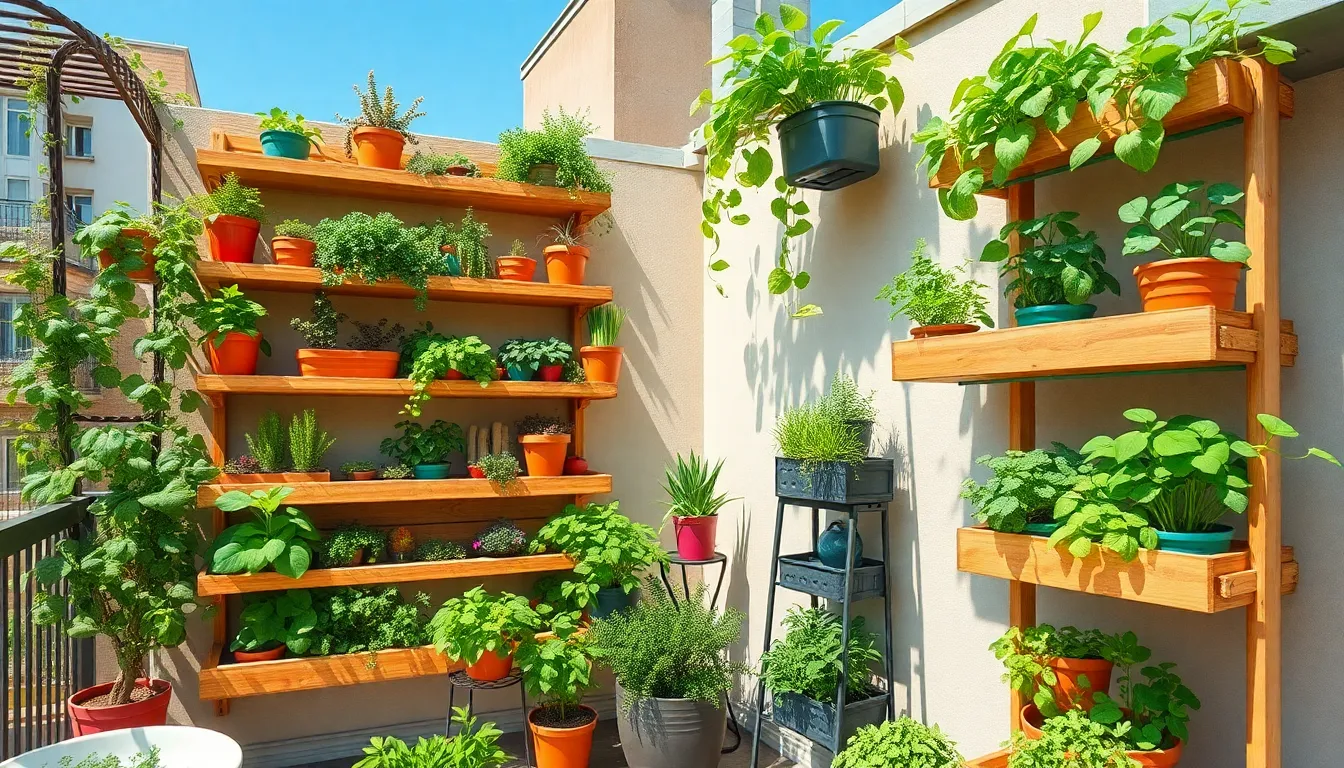
Vertical gardening maximizes small outdoor spaces by growing vegetables upward rather than outward, making it perfect for tiny yards, balconies, and patios. This approach saves space while improving air circulation and reducing the need to bend during garden care.
Trellis System Design
Trellis systems support climbing vegetables like beans, peas, cucumbers, and tomatoes by providing sturdy vertical frameworks. Wire, wood, or metal structures enable plants to grow upward, saving precious ground space while improving airflow that reduces disease risk. We recommend installing freestanding trellises or attaching them directly to walls and fences for maximum stability.
Modular pocket planters work beautifully when combined with trellis systems, creating ever-changing growing arrangements that use vertical wall space efficiently. This method doubles as living art when we incorporate flowering vines and trailing plants alongside our vegetables. Climbing crops benefit significantly from the improved air circulation that trellises provide, leading to healthier plants and better harvests.
Wall-Mounted Growing Answers
Wall-mounted systems transform blank vertical surfaces into productive vegetable gardens without sacrificing walking space. Pocket planters offer modular fabric or plastic pouches that we can arrange artistically on walls to hold soil and plants. These versatile containers accommodate shallow-rooted vegetables like herbs, lettuces, and strawberries perfectly.
Pallet gardens provide budget-friendly alternatives that repurpose wooden pallets into vertical growing spaces. We attach industry fabric to create individual compartments for different vegetables, maximizing our growing area while maintaining an organized appearance. Hanging pots and mounted containers add another dimension to wall-mounted answers, allowing us to grow diverse plant varieties in small footprints.
These wall-mounted options work especially well for urban gardeners who need to make the most of limited outdoor space while creating visually appealing growing areas.
Tiered Planting Structures
Tiered structures consist of stacked shelves, steps, or tower planters that create multiple growing zones vertically. A common design features a 5-tier vertical garden constructed with rust-resistant materials and proper drainage to prevent overwatering. These multi-level systems enable dense planting of herbs, leafy greens, and compact vegetables in remarkably limited spaces.
Portable tiered gardens equipped with wheels offer flexibility for repositioning based on sunlight requirements and seasonal changes. We can organize different crops by height and light needs, ensuring each plant receives optimal growing conditions. Tower planters work particularly well for strawberries, herbs, and cascading vegetables that naturally trail downward.
These structures provide practical and attractive ways to maximize our harvest while maintaining easy access for maintenance and harvesting tasks. Tiered designs accommodate various plant sizes and growth habits, making them ideal for beginning gardeners who want to experiment with different vegetables in organized, manageable sections.
Zone Garden Layout for Crop Rotation
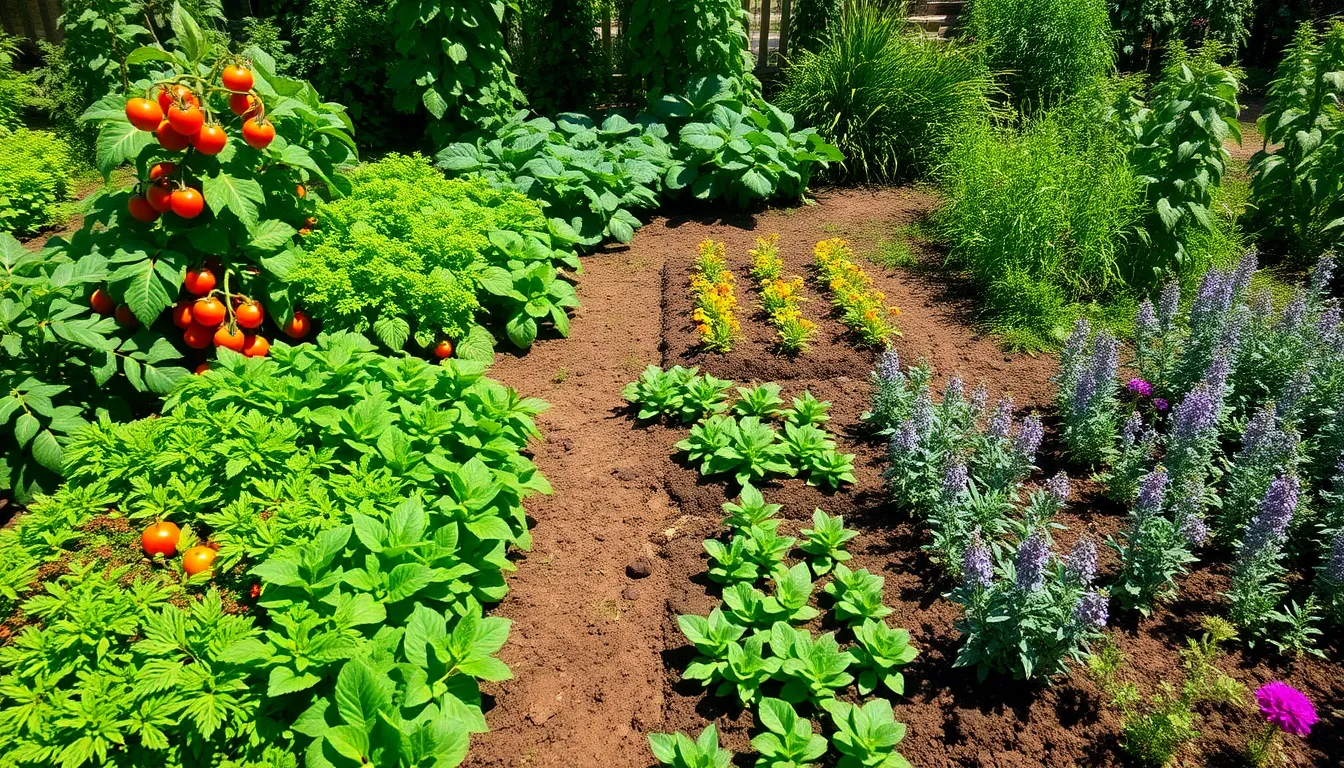
Garden zoning revolutionizes vegetable growing by segregating spaces based on crop needs and management intensity. We divide our growing areas into distinct zones that support systematic crop rotation while preventing soil depletion and pest buildup.
Four-Zone System Setup
Four distinct zones form the foundation of successful rotational vegetable gardening. Each zone serves a exact purpose in maintaining soil health and maximizing productivity:
Zone 1 accommodates heavy feeders like tomatoes, corn, and brassicas that require rich, nutrient-dense soil. These crops consume important amounts of nitrogen and other essential nutrients during their growing season.
Zone 2 houses light feeders including root crops like carrots and radishes, plus alliums such as onions and garlic. These vegetables thrive in moderately fertile soil without requiring intensive feeding.
Zone 3 focuses on soil builders, primarily legumes like beans and peas that naturally fix nitrogen from the atmosphere. These crops actually improve soil fertility while producing nutritious harvests.
Zone 4 serves as our permanent crop area or rest zone, featuring perennials, green manures, or fallow ground. This zone allows soil recovery while maintaining productive space for long-term plantings.
Seasonal Rotation Planning
Rotating crops through zones each growing season disrupts pest and disease cycles while balancing nutrient use. We move heavy feeders from Zone 1 to Zone 2 the following year, creating a systematic progression through all four zones.
Garden planning tools help us visualize and schedule rotations effectively. We map out which crops will occupy each zone across multiple seasons, ensuring optimal soil management and pest prevention.
Timing becomes crucial as we transition crops between zones during planting seasons. We coordinate plantings so soil-building legumes precede heavy feeders, while light feeders follow intensive crops to use remaining nutrients efficiently.
Soil Health Maintenance
Incorporating legumes throughout our rotation cycle fixes atmospheric nitrogen and improves overall soil fertility. We plant beans, peas, and other nitrogen-fixing crops strategically to rebuild depleted soils naturally.
Reducing soil compaction requires rotating deep-rooted crops with shallow-rooted varieties across zones. We alternate root vegetables with leafy greens and fruiting plants to maintain proper soil structure and aeration.
Adding organic matter through compost and mulch enhances each zone as crops rotate through them. We apply these amendments based on the exact needs of incoming crops and the condition left by previous plantings.
Allowing rest periods in at least one zone per growing cycle gives soil time to recover and regenerate. We use cover crops or temporary fallow periods to restore depleted zones while maintaining productivity in active growing areas.
Intensive Garden Layout for High Yield Production
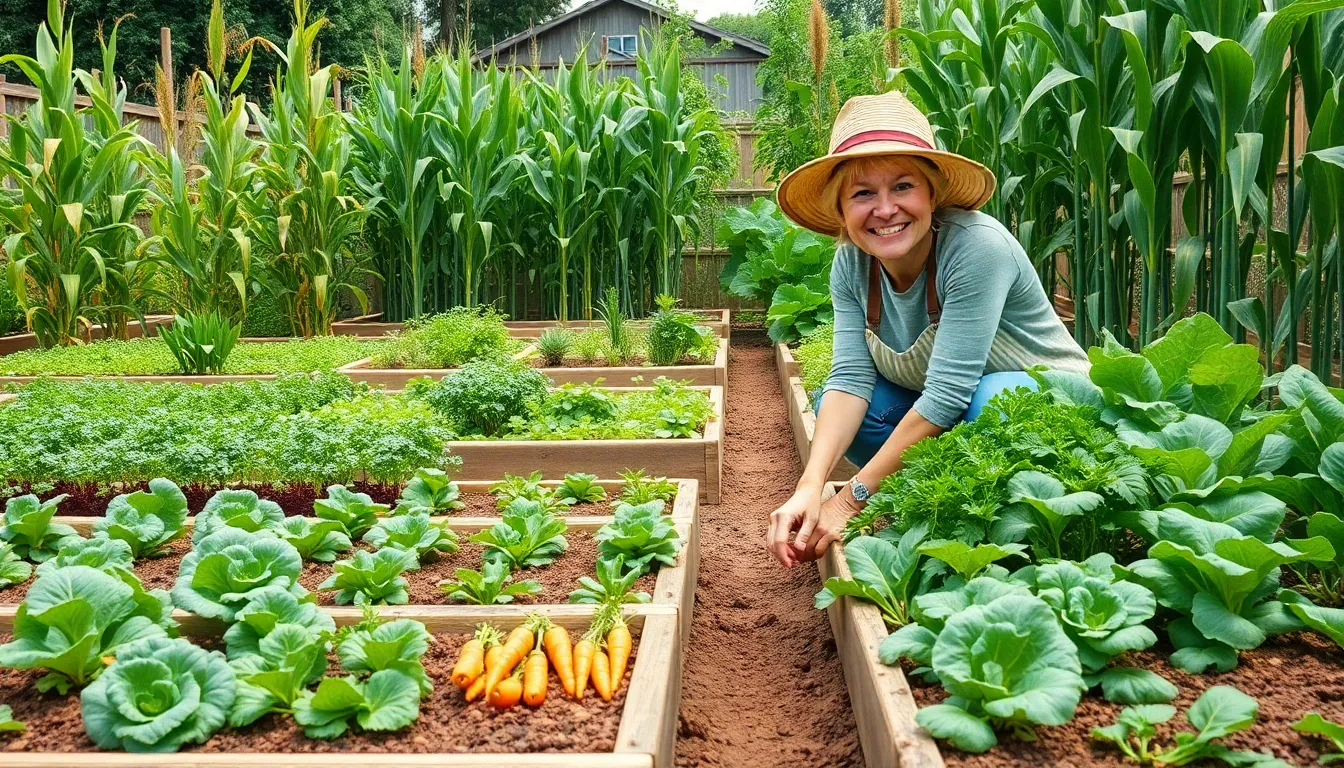
We’ll boost our vegetable production dramatically by implementing intensive gardening techniques that maximize every square foot of growing space. These methods focus on efficient soil use and strategic plant placement to create incredibly productive gardens.
Close Spacing Techniques
Broadcasting dense seedings transforms our garden beds into productive powerhouses by eliminating traditional row spacing. We plant crops like lettuce, carrots, and spinach by scattering seeds across wide bands of soil, then thin them to optimal density as they grow. This method creates a living carpet of vegetables that naturally suppresses weeds while maximizing our harvest per square foot.
Reducing spacing between larger plants allows us to fit more vegetables into our raised beds without sacrificing plant health. We space larger crops 18-36 inches apart instead of following conventional guidelines, adjusting distances based on each plant’s mature size. Dense foliage from properly spaced plants creates natural shade that retains soil moisture and prevents weed growth.
Creating wide growing bands in our 3-4 foot raised beds enables us to access plants from both sides while maintaining soil structure. We eliminate traditional narrow rows in favor of broader planting areas that accommodate multiple plants across the bed’s width. This technique dramatically increases plant density while keeping pathways clear for easy maintenance and harvesting.
Interplanting Strategies
Pairing fast and slow growing crops maximizes our garden’s productivity by utilizing different maturation timelines. We plant quick growing radishes among slower developing carrots, harvesting the radishes before they compete for space with the maturing root vegetables. This strategic timing allows us to double our harvest from the same growing area.
Using vertical companions creates beneficial microclimates while optimizing space usage in our intensive layout. We plant tall crops like corn to provide natural shade for heat sensitive greens growing beneath them. These vertical relationships protect delicate plants from harsh sun while utilizing the full height of our garden space.
Combining complementary root systems improves soil health while increasing our overall yield per square foot. We pair shallow rooted herbs with deep rooted vegetables to access different soil layers without direct competition. This layered approach to root placement ensures efficient nutrient uptake throughout our garden’s soil profile.
Continuous Harvest Methods
Succession planting schedules guarantee fresh vegetables throughout our growing season by staggering plantings every 2-3 weeks. We plant new crops in spaces vacated by harvested plants, replacing early peas with warm season corn to maintain continuous production. This method keeps our garden beds fully utilized from spring through fall.
Relay planting systems extend our harvest periods by making multiple plantings of the same crop at strategic intervals. We plant beans, corn, and cucumbers in successive waves to avoid overwhelming harvests while ensuring steady production. These overlapping plantings create a continuous supply of fresh vegetables for our table.
Integrated crop rotation maintains soil health while supporting our intensive production goals by dividing gardens into multiple beds. We rotate plant families annually between different sections to prevent nutrient depletion and break pest cycles. This systematic approach allows us to maintain high yields year after year while building soil fertility through strategic legume placement.
Conclusion
Creating the perfect veggie garden layout doesn’t have to be overwhelming when you have the right strategies in your toolkit. Whether you’re working with a tiny balcony or a sprawling backyard we’ve shown you multiple approaches that can transform any space into a productive growing area.
The key is choosing layouts that match your exact needs space constraints and gardening goals. From square foot methods to intensive growing techniques each approach offers unique benefits that can help you maximize your harvest while keeping maintenance manageable.
Remember that successful vegetable gardening is about finding what works best for your situation. Start with one layout that appeals to you experiment with the techniques and don’t be afraid to adapt these ideas to fit your unique growing conditions and preferences.
Frequently Asked Questions
What is square foot gardening and how does it work?
Square foot gardening is a method that divides garden beds into one-foot squares, maximizing yields in small spaces. Each square is planted based on the mature size of vegetables, with larger plants getting one square and smaller plants sharing space. This system reduces weeds, simplifies maintenance, and prevents overcrowding through organized grid planning.
How do I plan pathways between garden rows?
Plan pathways at least 18-24 inches wide between rows to allow easy access for maintenance and harvesting. Main pathways should be 3-4 feet wide for wheelbarrows. Strategic pathway placement prevents soil compaction and ensures you can reach all plants comfortably without stepping on growing areas.
What are the benefits of raised bed gardening?
Raised beds offer better drainage, improved soil control, and easier maintenance. They warm up faster in spring, prevent soil compaction, and allow for better crop management. Beds should be at least 18 inches deep and can be arranged in single or multiple configurations for flexibility in planting and crop rotation.
How does companion planting work in vegetable gardens?
Companion planting pairs compatible vegetables that benefit each other through pest deterrence, improved growth, or efficient space use. The Three Sisters method (corn, beans, squash) is a classic example where corn supports beans, beans add nitrogen to soil, and squash suppresses weeds while retaining moisture.
What is a keyhole garden layout?
A keyhole garden is a circular raised bed with a central composting basket that transforms kitchen scraps into plant nutrients. The design allows 360-degree access without stepping into the growing area, prevents soil compaction, and creates an efficient watering system that conserves moisture while maximizing space utilization.
How can I maximize vertical growing space?
Use trellis systems for climbing vegetables, install modular pocket planters on walls, and create tiered planting structures. Vertical gardening saves ground space, improves air circulation, and makes harvesting easier. Consider stacked planters, wall-mounted containers, and climbing supports to grow upward rather than outward.
What is zone garden layout for crop rotation?
Zone gardening divides your space into four areas: Zone 1 for heavy feeders, Zone 2 for light feeders, Zone 3 for soil builders (legumes), and Zone 4 for permanent crops or rest. Crops rotate through zones seasonally, disrupting pest cycles, balancing nutrient use, and maintaining soil health.
How do I practice intensive gardening techniques?
Intensive gardening maximizes production through close spacing, interplanting fast and slow-growing crops, and continuous harvesting methods. Use succession planting every 2-3 weeks, broadcast dense seedings for leafy greens, and reduce spacing between plants to create a living carpet that suppresses weeds naturally.
What vegetables work best for container gardening?
Compact varieties of tomatoes, peppers, lettuce, herbs, and root vegetables thrive in containers. Choose dwarf or bush varieties, ensure proper drainage, and group containers in odd numbers for visual appeal. Mobile container systems allow repositioning based on sunlight patterns and seasonal needs.
How do I create a spiral garden layout?
Build a spiral garden by arranging plants in a circular, ascending pattern that creates distinct microclimates. Place drought-resistant herbs at the top and moisture-loving plants at the bottom. This design maximizes diversity in compact spaces, allows easy access for maintenance, and creates an attractive focal point.


